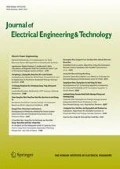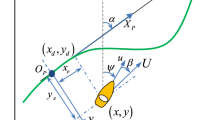Abstract
This paper is concerned with the path following control for an unmanned surface vessel subject to unknown dynamics and external disturbance. Firstly, an integral Line-of-Sight navigation strategy based on a fuzzy strategy to optimize lookahead distance to achieve faster convergence speed is proposed. Then a novel adaptive course control law based on trajectory linearization control technology is proposed, which is combined with the integral Line-of-Sight navigation strategy to form a complete unmanned surface vessel path following strategy. From the author's point of view, this is the first time that trajectory linearization control technology has been applied to the path following scheme by controlling the course. At the same time, in order to improve the robustness of the path following system, the unknown dynamics, external disturbance, and error in the system are compensated by neural network minimum learning parameter method with less computational complexity and a robust term, respectively. Furthermore, hyperbolic tangent function, Nussbaum function, and neural shunting model are introduced into the design of control law to solve the potential input saturation problem. Finally, the numerical simulation experiments of straight line and curve path following are given to prove the feasibility and universality of the whole set of path following scheme.













Similar content being viewed by others
References
Mousazadeh H, Jafarbiglu H, Abdolmaleki H, Omrani E, Monhaseri F, Abdollahzadeh M, Mohammadi-Aghdam A, Kiapei A, Salmani-Zakaria Y, Makhsoos A (2018) Developing a navigation, guidance and obstacle avoidance algorithm for an Unmanned Surface Vehicle (USV) by algorithms fusion. Ocean Eng 159:56–65
Fang Y, Pang M, Wang B (2017) A course control system of unmanned surface vehicle (USV) using back-propagation neural network (BPNN) and artificial bee colony (ABC) algorithm. Proced Comput Sci 111:361–366
Mu DD, Wang GF, Fan YS (2018) Tracking control of podded propulsion unmanned surface vehicle with unknown dynamics and disturbance under input saturation. Int J Control Autom Syst 16(4):1905–1915
Wang N, Karimi H R. Successive waypoints tracking of an underactuated surface vehicle, IEEE Transactions on Industrial Informatics, 2019.
Wang N, Xie G, Pan X, Su S (2019) Full-state regulation control of asymmetric underactuated surface vehicles. IEEE Trans Ind Electron 66(11):8741–8750
Zheng Z, Feroskhan M (2017) Path following of a surface vessel with prescribed performance in the presence of input saturation and external disturbances. IEEE/ASME Trans Mechatron 22(6):2564–2575
Zhang J, Sun T, Liu Z (2017) Robust model predictive control for path-following of underactuated surface vessels with roll constraints. Ocean Eng 143:125–132
Wang N, Pan X (2019) Path-following of autonomous underactuated ships: a translation-rotation cascade control approach. IEEE/ASME Trans Mechatron 20:20
Zheng Z, Huang Y, Xie L, Zhu B (2018) Adaptive trajectory tracking control of a fully actuated surface vessel with asymmetrically constrained input and output. IEEE Trans Control Syst Technol 26(5):1851–1859
Zheng Z, Jin C, Zhu M, Sun K (2017) Trajectory tracking control for a marine surface vessel with asymmetric saturation actuators. Robot Autonom Syst 97:83–91
Wang N, Su SF, Pan X, Yu X, Xie G (2018) Yaw-guided trajectory tracking control of an asymmetric underactuated surface vehicle. IEEE Trans Ind Inf 15(6):3502–3513
Wang N, Karimi HR, Li H, Su S (2019) Accurate trajectory tracking of disturbed surface vehicles: a finite-time control approach. IEEE/ASME Trans Mechatron 24(3):1064–1074
Fossen TI, Pettersen KY, Galeazzi R (2015) Line-of-sight path following for dubins paths with adaptive sideslip compensation of drift forces. IEEE Trans Control Sys Techn 23(2):820–827
Fossen TI, Lekkas AM (2017) Direct and indirect adaptive integral line-of-sight path-following controllers for marine craft exposed to ocean currents. Int J Adapt Control Signal Process 31(4):445–463
Fossen TI, Pettersen KY (2014) On uniform semiglobal exponential stability (USGES) of proportional line-of-sight guidance laws. Automatica 50(11):2912–2917
Breivik M, Fossen TI (2004) Path following for marine surface vessels. Proc OTO 4:2282–2289
Breivik M, Fossen TI (2004) Path following of straight lines and circles for marine surface vessels. IFAC Proc Vol 37(10):65–70
Borhaug E, Pavlov A, Pettersen KY (2008) Integral LOS control for path following of underactuated marine surface vessels in the presence of constant ocean currents. In: Decision and control. CDC 2008. 47th IEEE conference on IEEE, 2008, pp 4984–4991
Mu D, Wang G, Fan Y, Bai Y, Zhao Y (2018) Path following for podded propulsion unmanned surface vehicle: Theory, simulation and experiment. IEE J Trans Electr Electron Eng 13(6):911–923
Zheng Z, Sun L (2016) Path following control for marine surface vessel with uncertainties and input saturation. Neurocomputing 177:158–167
Lekkas AM, Fossen TI (2014) Integral LOS path following for curved paths based on a monotone cubic hermite spline parametrization. IEEE Trans Control Syst Technol 22(6):2287–2301
Caharija W, Pettersen KY, Bibuli M, Calado P, Zereik E, Braga J, Gravdahl JT, Sørensen AJ, Milovanovic M, Bruzzone G (2016) Integral line-of-sight guidance and control of underactuated marine vehicles: theory, simulations, and experiments. IEEE Trans Control Syst Technol 24(5):1623–1642
Mu D, Wang G, Fan Y (2017) Adaptive LOS path following for a podded propulsion unmanned surface vehicle with uncertainty of model and actuator saturation. Appl Sci 7(12):1232–1251
Oh SR, Sun J (2010) Path following of underactuated marine surface vessels using line-of-sight based model predictive control. Ocean Eng 37(2–3):289–295
Belleter D, Maghenem MA, Paliotta C, Pettersen KY (2019) Observer based path following for underactuated marine vessels in the presence of ocean currents: a global approach. Automatica 100:123–134
Liu L, Wang D, Peng Z (2016) Path following of marine surface vehicles with dynamical uncertainty and time-varying ocean disturbances. Neurocomputing 173:799–808
Mu D, Wang G, Fan Y (2017) Design of adaptive neural tracking controller for pod propulsion unmanned vessel subject to unknown dynamics. J Electr Eng Technol 12(6):2365–2377
Roh SB, Oh SK (2016) Identification of plastic wastes by using fuzzy radial basis function neural networks classifier with conditional fuzzy C-means clustering. J Electr Eng Technol 11(6):1872–1879
Wang N, Sun Z, Jiao Y, Han G (2019) Surge-heading guidance based finite-time path-following of underactuated marine vehicles. IEEE Trans Veh Technol 20:20
Wang N, Deng Z (2019) Finite-time fault estimator based fault-tolerance control for a surface vehicle with input saturations. IEEE Trans Ind Inform 20:20
Chen M, Ge SS, Ren B (2011) Adaptive tracking control of uncertain MIMO nonlinear systems with input constraints. Automatica 47(3):452–465
Mishra P, Panigrahi SK, Das S (2015) Ships steering autopilot design by Nomoto model. Int J Mech Eng Robot 3(3):37–41
Mu D, Zhao Y, Wang G and Fan Y (2016) USV model identification and course control, Information Science and Technology (ICIST), 2016 sixth international conference on, IEEE, pp 263–267
Zhao Y, Jim ZhuJ (2016) Automatic aircraft loss-of-control prevention by bandwidth adaptation. J Guid Control Dyn 40(4):878–889
Chen Y, Zhu JJ (2017) Car-like ground vehicle trajectory tracking by using trajectory linearization control. In: ASME 2017 dynamic systems and control conference. American Society of Mechanical Engineers, pp V002T21A014–V002T21A014
Zhao Y, Zhu JJ (2016) Aircraft loss-of-control arrest autopilot using trajectory linearization control. In: American control conference (ACC). IEEE, pp 1602–1607
Liu Y, Zhu JJ, Williams RL II, Wu J (2008) Omni-directional mobile robot controller based on trajectory linearization. Robot Auton Syst 56(5):461–479
Wen C, Zhou J, Liu Z, Su H (2011) Robust adaptive control of uncertain nonlinear systems in the presence of input saturation and external disturbance. IEEE Trans Autom Control 56(7):1672–1678
Chen C, Liu Z, Zhang Y, Chen CLP, Xie S (2016) Saturated Nussbaum function based approach for robotic systems with unknown actuator dynamics. IEEE Trans Cybern 46(10):2311–2322
Xudong Y, Jingping J (1998) Adaptive nonlinear design without a priori knowledge of control directions. IEEE Trans Autom Control 43(11):1617–1621
Zadeh LA (1996) Toward a theory of fuzzy systems, fuzzy sets, fuzzy logic, and fuzzy systems. Selected papers by Lotfi A Zadeh, pp 83–104
Zadeh L (2008) Fuzzy logic. Computer 21(4):83–93
Li T, Wang D, Feng G, Tong S (2010) A DSC approach to robust adaptive NN tracking control for strict-feedback nonlinear systems. IEEE Trans Syst Man Cybern Part B Cybern A Publ IEEE Syst Man Cybern Soc 40(3):915–927
Yang Y, Ren J (2003) Adaptive fuzzy robust tracking controller design via small gain approach and its application. Fuzzy Syst IEEE Trans 11(6):783–795
Pan CZ, Lai XZ, Yang SX, Wu M (2015) A biologically inspired approach to tracking control of underactuated surface vessels subject to unknown dynamics. Expert Syst Appl 42(4):2153–2161
Khalil HK (1996) Noninear systems, 2(5). Prentice-Hall, New Jersey, p 51
Mu D, Wang G, Fan Y, Sun X, Qiu B (2018) Modeling and identification for vector propulsion of an unmanned surface vehicle: three degrees of freedom model and response model. Sensors 18(6):1889–1910
Acknowledgements
This work was supported by "the Nature Science Foundation of Liaoning Province of China" (Grant number 20180520005), "the Nature Science Foundation of China" (Grant number 51609033), "the Fundamental Research Funds for the Central Universities" (Grant numbers 3132018306 and 3132016312) and "China Scholarship Council" (Grant number 201806570006).
Author information
Authors and Affiliations
Contributions
The author ensures that the paper is original works and does not leak state secrets, non infringement. If a leak or infringement of the issue, the author shall bear all the responsibilities. The author ensures that the right of authorship is not disputed. If there is a dispute over the right of authorship, the author shall bear all the responsibilities. This paper has made a clear description of the results of the reference to other people's achievements in the text. The author ensures that the paper does not submit the manuscript to other journals.
Corresponding author
Ethics declarations
Conflict of interest
The authors declare no conflict of interest.
Additional information
Publisher's Note
Springer Nature remains neutral with regard to jurisdictional claims in published maps and institutional affiliations.
Rights and permissions
About this article
Cite this article
Mu, D., Wang, G. & Fan, Y. A Time-Varying Lookahead Distance of ILOS Path Following for Unmanned Surface Vehicle. J. Electr. Eng. Technol. 15, 2267–2278 (2020). https://doi.org/10.1007/s42835-020-00443-4
Received:
Revised:
Accepted:
Published:
Issue Date:
DOI: https://doi.org/10.1007/s42835-020-00443-4




